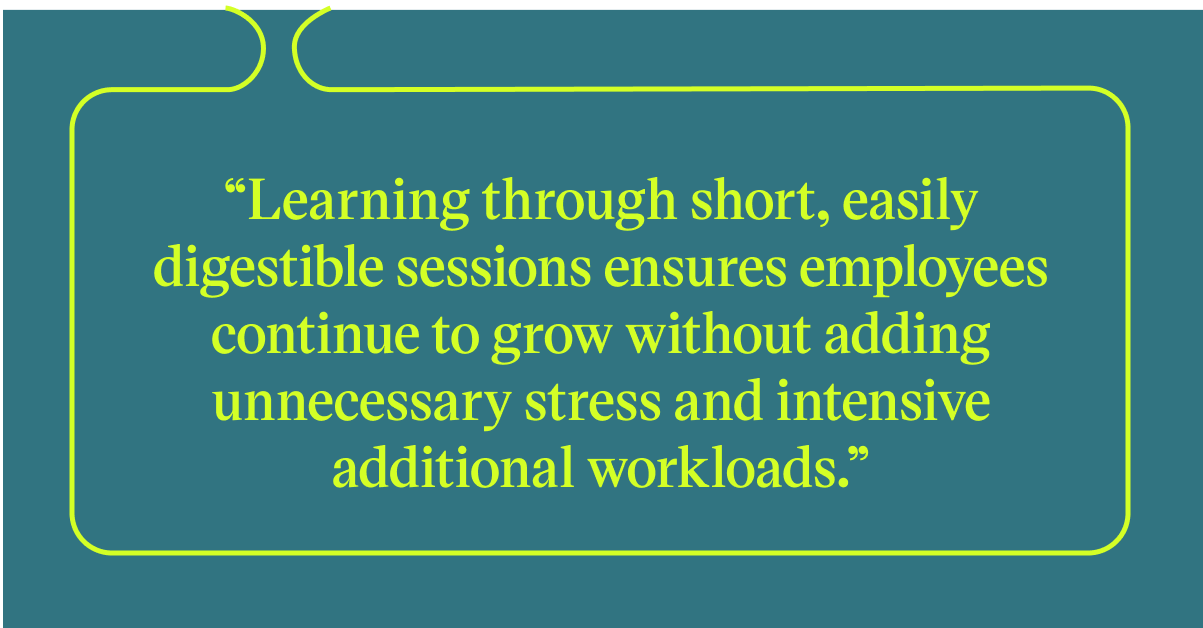
How to use micro-credentials in employee learning and development

In today’s fast-paced workplace, employees can find it difficult to dedicate time to learning and development. However, this is counter-productive. Not only does failing to dedicate time to L&D stagnate employee growth, but it also stagnates business growth. When employees can't learn new skills and develop their knowledge, they can’t improve their performance.
However, one convenient, accessible, and low-pressure way employees can develop is through micro-credentials. Learning through short, easily digestible sessions ensures employees continue to grow without adding unnecessary stress and intensive additional workloads.

Accordingly, we’ll explore the benefits of micro-credentials, including some of the most popular micro-credential topics and how you can introduce this effective learning technique to your organization.
What are micro-credentials?
Micro-credentials are short, accessible credentials that allow an employee to learn a skill or piece of information. Rather than a long and detailed course that covers numerous topics, micro-credentials cover a specific topic in an accessible way. Over time, when an employee obtains several micro-credentials, it will contribute to learning valuable new skills that they can apply at your organization.
What are the benefits of micro-credentials?
Micro-credentials offer busy employees a flexible and convenient way to learn and develop. Below are some of the benefits of micro-credentials.
- Employees can learn specific skills that align with the goals of your organization.
- Employees learn in bite-sized chunks that increase engagement and retention.
- They ensure employees aren’t overwhelmed with daunting workloads that seem unachievable.
- They are valuable when developing personalized learning at scale.
- They ensure you can evolve with industry trends by providing reactive training quickly and easily.
- They build a culture of learning in your organization.
- They help increase productivity, efficiency, and confidence, ensuring your employees can provide better service.
- They help employees feel more valued and can lead to lower employee turnover.
How to align micro-credentials with your organization's goals
While micro-credentials offer the flexibility and convenience employees need to learn, it’s also important to ensure they align with your organization’s goals. Here are some steps your business can take to ensure the two are synced.
- Understand what skills your employees need to meet organizational goals and objectives.
- Perform a skills gap analysis to identify which skills your employees need to develop.
- Use data as part of employee reviews to understand how employees can improve.
- Identify which micro-credentials align with skills gaps, employee goals, and organizational objectives.
- Build micro-credentials into employees’ development goals.
- Communicate the value of micro-credentials and how they contribute to employee growth and the overall success of your business.
- Offer incentives and gamification to increase employee engagement.
- Ensure employees have the opportunity to use the skills and knowledge they learn.
What are common micro-credentials employees can gain?
One of the main advantages of micro-credentials is that they are available across a wide range of topics. Some of the most common micro-credentials your employees can gain include:
- Technical skills, such as software development and data analysis
- Software skills, such as Microsoft Excel and Word
- Project management skills, such as organization, planning, and risk management
- Communication skills, such as presentation skills and teamwork
- Leadership skills, such as delegation, team building, and conflict resolution
- Customer service skills, such as problem-solving and active listening
- Sales skills, such as negotiation and relationship building
- Diversity and inclusion, such as how to build an inclusive workplace
- Soft skills, such as time management, emotional intelligence, and resilience
- Industry-specific knowledge, such as compliance training
- Health and safety knowledge, such as first aid and fire safety
What are the challenges of micro-credentials?
Micro-credentials allow for a greater level of accessibility, flexibility, and convenience. As a result, courses are divided into manageable chunks that don’t overwhelm employees. This can give some stakeholders the impression that micro-credentials don’t offer the same depth as other courses. However, this isn’t the case.

Similarly, because so many micro-credentials are available, it can be hard to know where to start. Following the above steps can help your organization identify which skills your employees would benefit from developing first.
Because micro-credentials aren’t considered a ‘traditional’ way of learning, it may also be challenging for some organizations to accept the validity of certain courses.
How can you utilize micro-credentials in your organization?
You likely already provide your employees with resources, courses, and materials that allow them to develop. So, introducing micro-credentials shouldn’t require major changes to your existing learning and development strategy, as it simply offers a new way of learning that fits into what you’re already doing.
Micro-credentials can integrate with your learning management system (LMS) so employees can access training when convenient. You can also view how employees engage with their training and if they need additional support.
Because micro-credentials are more accessible, employees are more likely to engage and are in a better position to upskill. This also allows your business to recognize achievements more regularly, enhancing your reputation as an employer that values development.
How Go1 helps
At Go1, we have a range of online courses for your micro-credentials strategy. For more information on how Go1 can support your learning and development program, speak to one of our experts today. Or, download our 5 essential tools to help you develop a future-fit organization.




